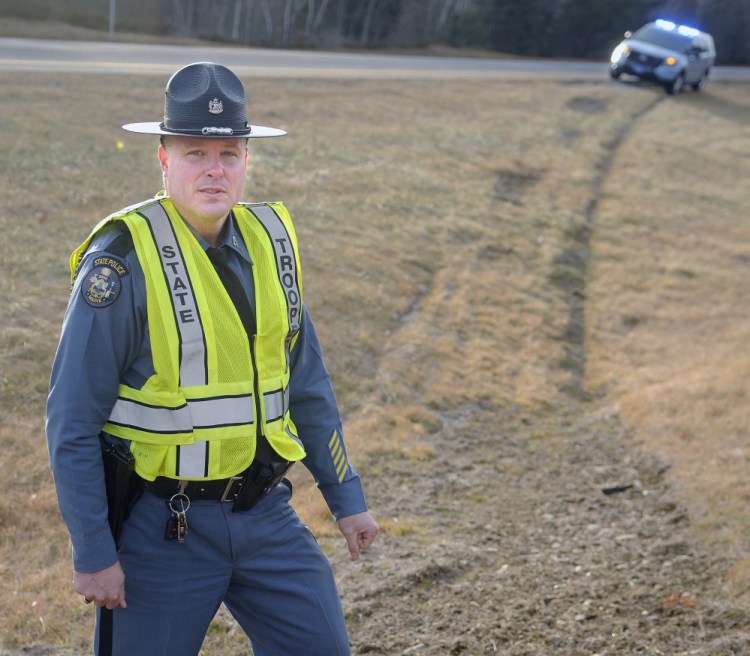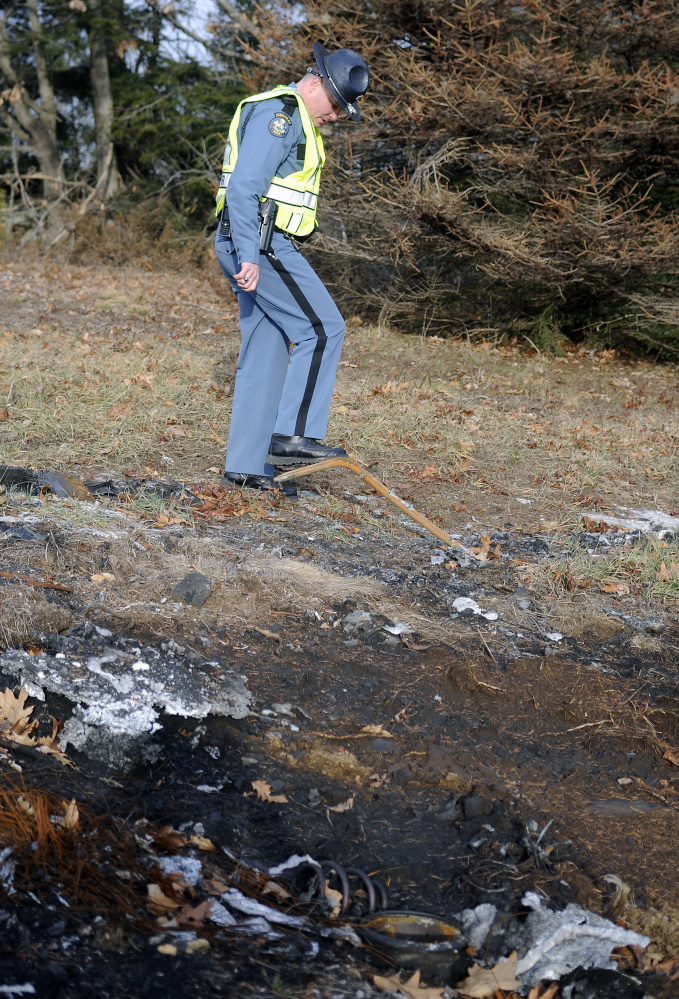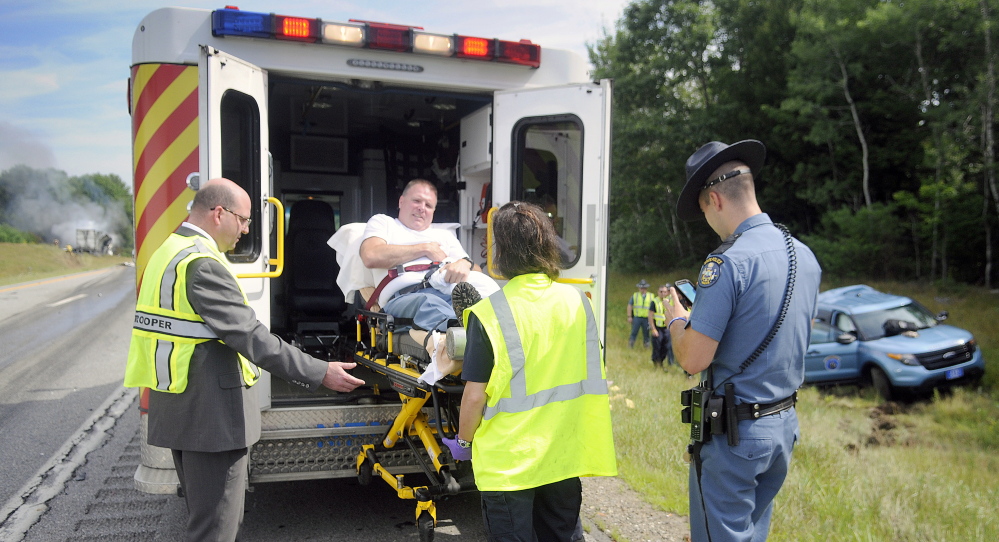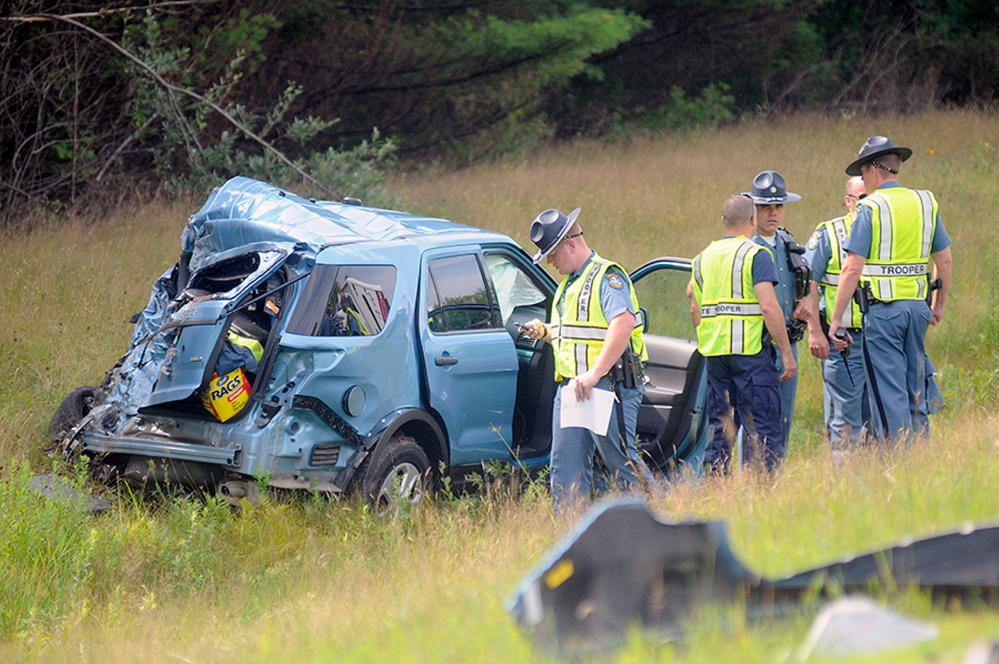Trooper Greg Stevens got just a glimpse of the tractor-trailer barreling down on his cruiser an instant before the impact. He had just enough time to floor the accelerator in a desperate bid to get out of the way.
It didn’t work.
The truck slammed into the back of Stevens’ cruiser, sending the trooper flying back behind the front passenger’s seat. When Stevens came to, he was able to crawl his way out of the mangled SUV before help arrived, but he would spend roughly three months in often painful recovery before returning to work in October.
“I had a lot of something watching out for me,” Stevens said. “God was with me. Everything fell into place to keep me alive.”
The July 30 crash offered another stark reminder of the importance of Maine’s Move Over law, which requires drivers to slow down and, if possible, move over to give police, firefighters and other emergency responders a wide berth when they are stopped on the side of the road.
“I always want the motorists to remember that is someone’s brother, or father, or wife or mother, out on the road,” Stevens said.
Despite suffering a concussion, Stevens easily recalls the details of the crash, beginning with the setting. It was a little before 10 a.m. on a clear, bright day.
Stevens, 44, who has worked in law enforcement for 22 years, the last 17 with the state police, pulled his cruiser in behind a tractor-trailer that had broken down in the northbound lane of Interstate 295 near mile 46. The truck driver had just gotten his rig running and merged back into traffic as Stevens completed a brief report on the stop inside his cruiser. His cruiser was parked in the breakdown lane on the right side of the road with its emergency lights flashing. He said there were no curves or hills in the area to obscure the view of approaching drivers.
Stevens finished his report just in time to look up and see in his mirror that an approaching tractor-trailer was veering right toward his cruiser. The driver of that truck, 56-year-old Gusan Yedic, of Yorktown Heights, New York, told crash investigators he had blown a tire, but Stevens said that doesn’t square with other details of the investigation. Stevens probably will never know what happened.
“There’s no rhyme or reason why he would have hit me,” he said.
Stevens, who had just put the cruiser in drive to pull back into traffic, slammed his foot onto the accelerator to try to get out of the way. He doesn’t recall it, but witnesses said he tried to move to the right, farther away from the travel lane, to avoid the crash, but the truck still smashed into the back of the cruiser, making direct impact with the driver’s side rear. The impact crushed the back of the Ford Police Interceptor.
“It was like going from zero to 55 in a second,” Stevens said.
He was thrown backward. His body was pushed to the right, away from the worst of the impact, by the airbag that exploded from his steering wheel. Stevens ended up sprawled behind the passenger’s seat inside the destroyed cruiser, which came to a rest down a grassy embankment. He was dazed by the concussion but still managed to get out on his own.
“I couldn’t remember while I was there,” he said.
Yedic and the tractor-trailer, meanwhile, caromed off the cruiser and swerved left across both lanes. The truck came to a rest in the median and was soon engulfed in flames. The fire was knocked down within an hour, but there was a lengthy cleanup, including a large diesel fuel slick that spilled across the road after the crash. The fire briefly spread to the grass in the median before firefighters doused the flames.
Yedic escaped the crash and the fire uninjured, but the truck, owned by Illinois-based Yamamoto Carrier Inc., and the trailer, which was empty, were both destroyed.
Public safety dispatchers, unable to reach Stevens on the radio, soon began taking calls of a Maine State Police cruiser involved in a crash. Dispatchers called police in the area to check on the trooper, which signaled a blitz of officers rushing to the scene to check on Stevens. With his radio equipment destroyed by the impact, Stevens never heard any of it.
Stevens said he remembers people running toward his cruiser to help him and he recalls seeing a fire, though he couldn’t tell what was burning. He was angry he had been hit, but he was not afraid.
“Not for one minute did I think I was going to die,” Stevens said, but his injuries, including a neck broken in two places and five broken ribs, would require months of rest and rehabilitation.
“That was the worst part,” Stevens said of the rib injury.
Stevens, who has a female partner and two daughters, ages 15 and 13, knew his loved ones would hear about the crash, so his first thought was to let them know he was safe.
“They were my first call when I got in the back of the ambulance,” he said.
Both northbound lanes were closed for nearly two hours as traffic backed up for several miles after the crash. Police and firefighters remained on scene for several hours, cleaning up the site and investigating the crash.
Stevens was rushed by ambulance to Maine Medical Center in Portland, where he remained for nearly a week. He would have stayed longer, but his room was in a section of the hospital without air conditioning. The heat, coupled with the bandages, was too much to bear. Kennebec Pharmacy provided a hospital bed that allowed Stevens to recover at home. He received regular physical therapy to get back to work.
“It was a big push to get better,” he said.
‘VISIBILITY FACTOR’
Stevens has never talked to Yedic, who was issued a summons charging him with failing to move over for an emergency vehicle. His case is still pending in court, and if found guilty of the violation, Yedic faces a potential penalty of a $311 fine.
He is one of dozens of drivers to face the charge after hitting a cruiser since the Move Over law was passed in 2007. The most recent figures were not immediately available, but Stevens’ troop commander, Lt. Aaron Hayden, said in 2013 that in the previous three years, 24 cruisers had been hit from behind while their emergency lights were flashing. Those crashes left 12 troopers injured.
Hayden said at the time that 75 state police cruisers were struck from behind from 2008 to 2013, but that number includes cruisers that were hit while moving in traffic. Hayden said it’s impossible to know what percentage of those cruisers was stopped with its emergency lights flashing, but he said the number was significant enough to prompt the state in 2010 to begin keeping statistics on such crashes.
Maj. Brian Scott, of the Maine State Police, said the agency has conducted extensive testing in recent years on techniques to make cruisers and troopers more visible. As a result, cruisers are now being outfitted with high-intensity light bars on the roof and improved reflective stickers on the back. Stevens’ cruiser is the first to have stickers and the light bar, though all the cruisers will be retrofitted in the coming months, Scott said. The agency also is rolling out high-visibility vests that troopers can wear while working an emergency scene.
“The visibility factor was significant,” Scott said of the new safety equipment. “The difference when you look at these at nighttime is absolutely amazing.”
It’s too early to know whether the improved visibility will cut down on the number of crashes, but state officials will track that information over the coming years. He said similar measures undertaken by Massachusetts State Police have received positive reviews.
“Anecdotally, we believe it will make a big difference,” Scott said.
There is a balance, Scott said, between visibility and invisibility when it comes to effective police work. Visibility is important when directing traffic or stopped beside the road at an emergency scene, but invisibility is crucial to discovering lawbreakers or when trying to avoid someone with intentions of injuring an officer. Scott said the agency tried using more low-profile cruisers. The cars blended better, meaning they were more effective in catching people violating the law, but they also wound up getting hit more frequently. The high-visibility lights, stickers and other equipment is the agency’s response to that problem.
“We’re taking these steps to make sure they’re safer and the public is safer,” Scott said.
Stevens said he is very grateful for the agency’s effort to “keep troopers safe” and he believes it will pay off. He agrees that the stickers are much more visible and he raves about the new light bar.
“It seems to catch your attention better,” he said.
FEELING GRATEFUL
The July crash was the second time his cruiser has been hit from behind while working for the state police. The first time it happened, several years ago, Stevens was outside his cruiser and the impact vaulted him onto the car’s hood. His police dog, which was still in the car, was not hurt even though the vehicle sustained significant damage.
The July crash also marked the second time Stevens has broken his neck on the job. He suffered a single break in 2006 when he fell into an abandoned well during a search.
“I’m doing all right,” Stevens said with a smile when asked if he’s suffered any long-term effects.
Stevens said he is doing as well emotionally as he is physically. There has been no hesitancy, or fear, about stopping and working on the interstate. He understands now, as he did before, that he works in a dangerous job.
“After living through that, it is what it is,” Stevens said. “There’s nothing I can do about it.”
Whatever negatives might have come out of the crash were swallowed up by the support Stevens said he continues to receive from his friends and family, the state police and the public. He keeps in his cruiser a businesses card of a FBI agent sent to Stevens by the agent’s daughter with a note of encouragement. That was just one of the countless gestures of kindness and support that Stevens said came from every direction after the crash, from his hometown, Pittston, and local businesses, to the trooper’s wife who started a Facebook page to update people on his condition.
“What helped me get through this is all the support I had,” he said.
Stevens said he’ll never be able to repay people for all the kindness he has been shown.
“What do you say?” he said. “They all just came together. I’m really grateful.”
Stevens said the experience rejuvenated his passion for law enforcement and helping others.
“It changes your perspective,” he said. “It makes you feel good that you’re doing what you’re doing.”
Craig Crosby — 621-5642
Twitter: @CraigCrosby4
Send questions/comments to the editors.







Success. Please wait for the page to reload. If the page does not reload within 5 seconds, please refresh the page.
Enter your email and password to access comments.
Hi, to comment on stories you must . This profile is in addition to your subscription and website login.
Already have a commenting profile? .
Invalid username/password.
Please check your email to confirm and complete your registration.
Only subscribers are eligible to post comments. Please subscribe or login first for digital access. Here’s why.
Use the form below to reset your password. When you've submitted your account email, we will send an email with a reset code.